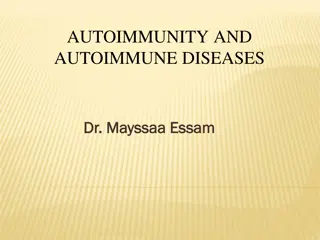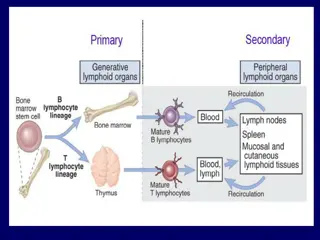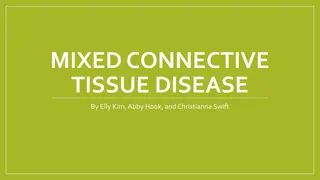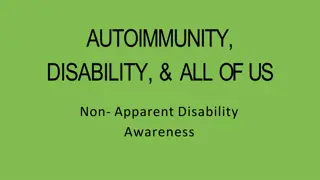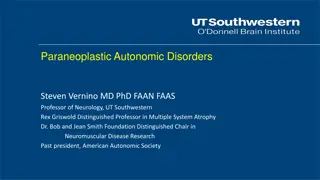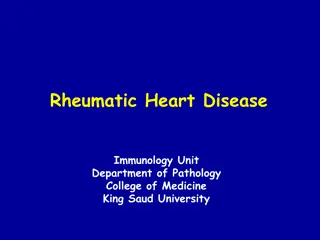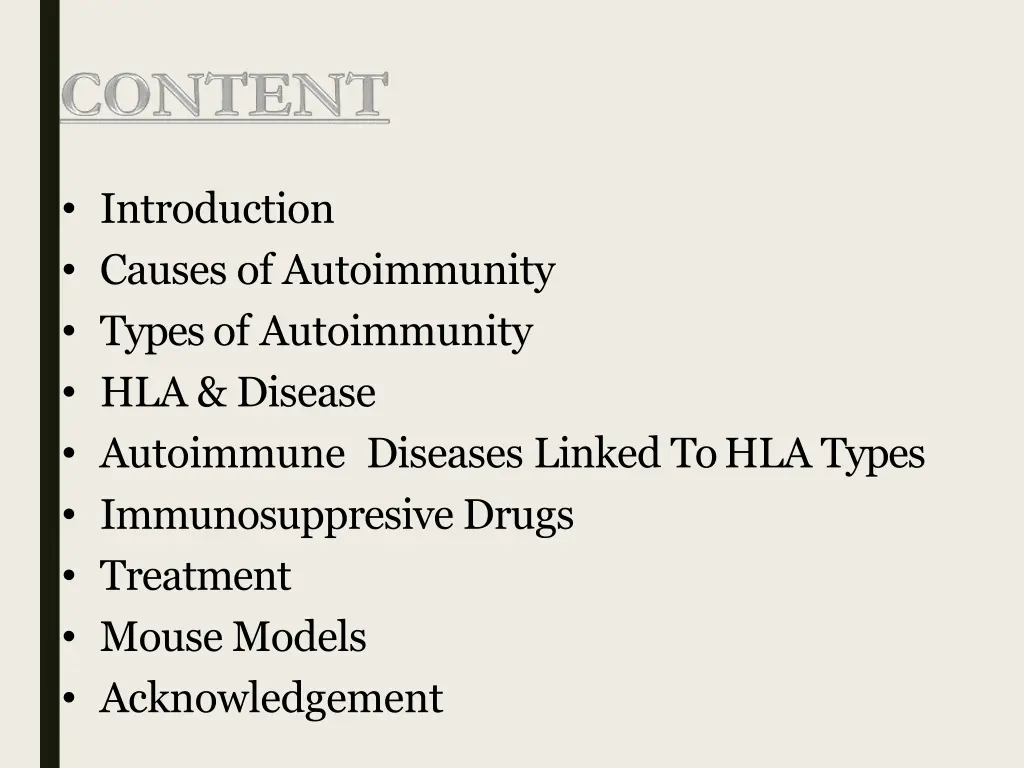
Understanding Autoimmune Diseases: Causes, Types, and Treatment
Explore the complexities of autoimmune diseases, where the body's immune system attacks its own tissues, leading to various disorders. Learn about different types, such as haemolytic, systemic, and localized autoimmune diseases, their causes, associated HLA types, and treatment options including immunosuppressive drugs. Dive into specific conditions like Hashimoto's thyroiditis, myasthenia gravis, and multiple sclerosis to understand the impact of autoimmune responses on organs and tissues.
Download Presentation

Please find below an Image/Link to download the presentation.
The content on the website is provided AS IS for your information and personal use only. It may not be sold, licensed, or shared on other websites without obtaining consent from the author. If you encounter any issues during the download, it is possible that the publisher has removed the file from their server.
You are allowed to download the files provided on this website for personal or commercial use, subject to the condition that they are used lawfully. All files are the property of their respective owners.
The content on the website is provided AS IS for your information and personal use only. It may not be sold, licensed, or shared on other websites without obtaining consent from the author.
E N D
Presentation Transcript
Introduction Causes of Autoimmunity Types of Autoimmunity HLA & Disease Autoimmune Diseases Linked To HLA Types Immunosuppresive Drugs Treatment Mouse Models Acknowledgement
Introduction Autoimmune diseases is a group of disorders in which tissue injury is caused by humoral (by auto-antibodies) or cell mediated immune response (by auto-reactive T cells) to self antigens. An autoimmune disorder may result in: The destruction of one or more types of body tissue Abnormal growth of an organ Changes in organ function
Haemolytic autoimmune diseases Auto - immune Diseases Systemic autoimmune diseases Localised autoimmune disease
1. Haemolytic autoimmune diseases Clinical disorder due to destructions of blood components. Auto Ab are formed against one s own RBCs, Platelets or Leucocytes . E.g. Thrombocytopenia, etc. Haemolytic anaemia, Leucopenia,
2. Localised autoimmune disease A particular organ is affected due to autoAbs. - For example: Thyroiditis (attacks the thyroid) Multiple sclerosis (attacks myelin coating of nerve axons) Myasthenia gravis junction) Juvenile diabetes or Type I DM (attacks insulin- producing cells) (attacks nerve-muscle
Hashimotos thyroiditis Hypothyroidism & destruction of thyroid cells. Characterised by Goitre, enlarged thyroid gland. Characterized by Type IV hypersensitive reactions. It is a T-cell associated auto immune disease .
Myasthenia Gravis Caused by muscle auto antibody against Antigen & acetylcholine receptorantigen. Characterized by muscular weakness Eventually death from respiratory failure. Neuromuscular junction is severely affected.
Multiple Sclerosis Degeneration of nerves CNS (brain and spinal cord). Myelin disappear due inflammation.
Type I diabetes cells produce little or no insulin. Heritable Symptoms are like being very thirsty, hungry, tired or fatigued, urinating moreoften.
3. Systemic autoimmune disease Non organ-specific autoimmune diseases Immune complexes accumulate in many tissues and cause inflammation and damage. For example: Systemic Lupus Erythematosus Ab.): Harms kidneys, heart, brain, lungs, skin. Rheumatoid Arthritis Joints, hearts, lungs, nervous system. Rheumatic fever: antibodies to streptococcus and auto-antibodies. (anti-nuclear (anti-IgG antibodies): cross-reaction between
Systemic Lupus Erythematosus (SLE) Skin disease due to the production of antinuclear factor (ANF) . In these patients, neutrophil) appears marrow Function Phagocytosis in the presence of ANF. LE cell (a mature in blood & bone
RheumatoidArthritis Disease of the joints. Caused by the auto Antibody of IgM type, called as rheumatoid factors. The synovial fluid of these patients contain increased no. of T-cells & macrophages. Marked by inflammatory changes synovial membrane. in the In later stage, deformity develops.
Condition of Rheumatoid Artheritis
HLA Disease Major histocompatibility complex (MHC) in humans . This group of genes resides on chromosome6. HLAs belongs to MHC class I present peptide from inside the cell which are degraded by proteasomes.
HLAs corresponding to MHC class II present antigens from outside of the cell to T- lymphocytes. HLAs corresponding to MHC class III encode components of the complement system.
Role of HLA 1. In infectious disease 2. In graft rejection 3. In autoimmunity 4. In cancer
Autoimmune diseases linked to HLAtypes Diabetes Graves' disease Hashimoto's thyroiditis Lupus Multiple Sclerosis Myasthenia gravis RheumatoidArthritis
Immunosuppresive Drugs Drugs that inhibit or prevent activity the immune system. They are used therapy to: Prevent the rejection of transplanted organs tissues (e.g., bone liver) Treat autoimmune (e.g., rheumatoid of in immunosuppressive and marrow, heart, kidney, diseases multiple arthritis,
Immunosuppressive drugs can be classified into four groups: o Glucocorticoids (suppress allergic, inflammatory and autoimmune disorders) . o Cytostatics (inhibit cell division) . o Antibodies (prevent the acute rejection and targeted treatment of or autoimmune disorders) . o Drugs Tacrolimus) . acting on immunophilins (Ciclosporin,
Treatment The key to treating autoimmunity is immunomodulation . Some autoimmune diseases are treated with medications that enhance specific symptoms. Haemolytic anaemia: Treated with Vit B12 SLE : Treated with nonsteroidal anti-inflamatory drugs such as ibuprofen or naproxen, corticosteroids. antimalarial drugs, and In more aggressive cases, immunosuppressive drugs may be used.
MouseModels Human Disease Mouse Models RheumatoidArtheritis Collagen InducedArthritis (CIA) Multiple Sclerosis ExperimentalAutoimmune Encephalitis (EAE) Diabetes Non Obese Diabetic (NOD) MRLlpr Lupus



